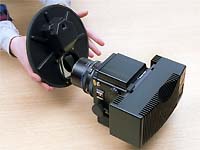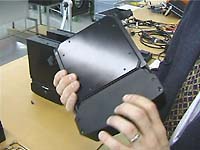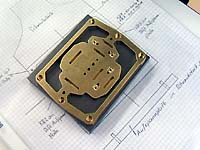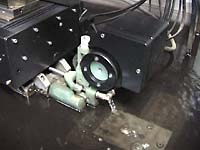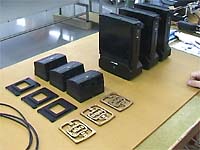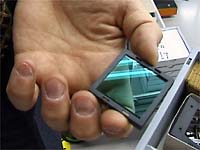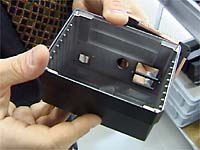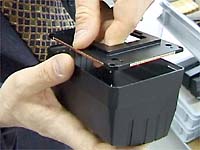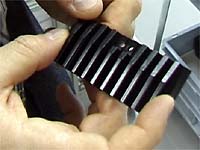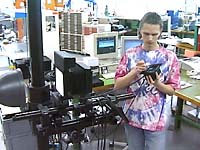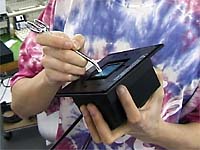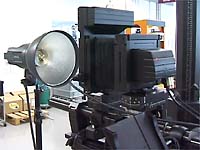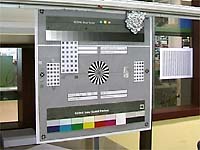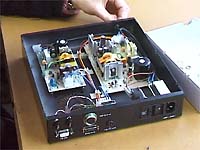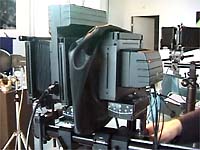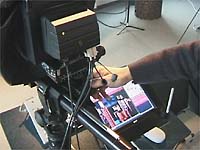The first complete professional digital camera system
by John Henshall
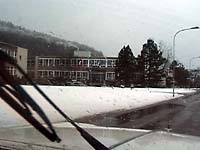 |
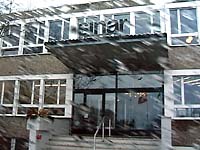 |
ANALOGUE BEGINNINGS
The story of the founding of Sinar could easily be the story of any inventive photographer with a burning desire to improve the equipment he works with.
Carl August Koch was a Swiss GP (General Practice) photographer whose studio in the northern town of Schaffhausen, close to the German border, flourished in the late nineteenth century. Half a century later his grandson, Carl Koch, continuing the family business, was frustrated by the design of the contemporary view cameras he was using. So he designed his own modular camera, which could be adapted to suit any situation a photographer might be faced with.
Koch wanted to remain a photographer, not become a camera manufacturer. He offered his design to a major German manufacturer of view cameras but they could not accept that a photographer could design a better camera than their own engineers. But interest in his design was high, so he had a few cameras made. Word got around and photographers from Belgium wanted to buy the camera, so the business took off. He sold his studio and opened up a factory to make his camera system, which has since moved on through five decades of technological innovation, including electronic and digital.
One of the first Sinar
prototypes -- the Norma -- designed by Carl Koch
during the second World War and made in
1948. It can be taken apart -- for
example to remove the bellows and replace them with
a bag bellows -- -- and adapted to any situation
a photographer could need. The design and modular
construction was so good that even this prototype
can be updated to digital. The rail takes U2-size
batteries for flash triggering, that is why it is
the shape it is. Today's Sinars still use the same
basic rail. Early models can still be
serviced. There is no "planned obsolescence"
-- -- and spare parts for older
models are still stocked -- -- or manufactured as
required. Sinar have always been at the
forefront of innovation and improvement. This is
the auto aperture shutter, still used
today. The Expolux shutter was the
first digital shutter. Designed in the 1970s, this
was Sinar's first move into electronics --
experience which has proved valuable in the move
into digital photography. Another Sinar 'first' was TTL
exposure measurement at the film plane, in 1967.
This is a probe from the late '70s. Rollfilm backs were an important
product before the digital age. They were the first
devices to be able to image different formats on
the same film, a technique later adopted by the APS
system and the Hasselblad/Fuji XPan
camera. Masking-off all light which does
not actually contribute to the forming of the image
eliminates flare and improves image contrast and
colour saturation more than any other single
factor. Most of the machinery in the
Sinar factory is very sophisticated and modern.
This is the oldest. It is still used to make the
camera rails -- -- and was itself made by
another famous-name company, Hispano
Suiza. Sinar products are still
assembled by hand from a multitude of parts. It's a
skilled job which invests many hours of work in the
products.
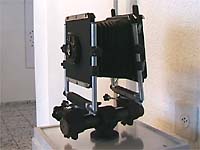
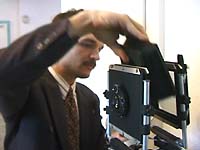
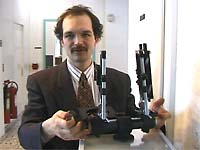
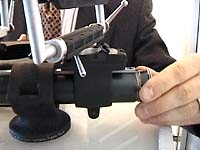
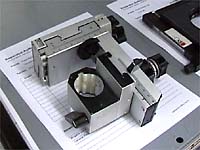
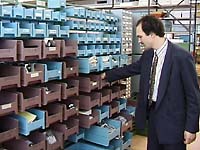
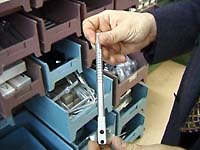
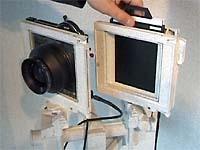
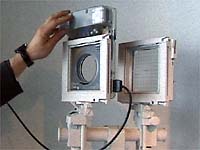
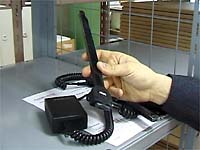
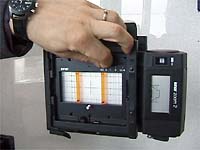
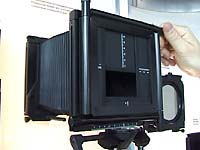
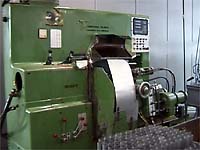
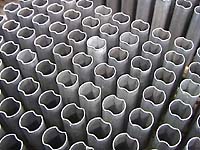
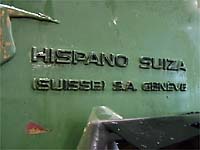
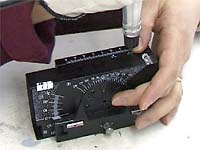
DIGITAL FRONT -- THE SINARCAM
Sinar's entry into digital cameras was almost by accident, after Photokina in 1992. They had been advised that the size of digital file necessary to match the quality obtainable from silver halide for A4 reproduction was so huge that it would preclude digital photography ever becoming a reality. Yet there at Photokina, on the booth right next to them, were Leaf with their new Digital Camera Back. Leaf were producing beautiful images far bigger than A4 from file sizes of only 12MB.
|
|
|
|
|
Good as Leaf's DCB was, some of its features left room for improvement. One was the external front-of-lens filter wheel housing for rotating gelatin RGB filters, through which the three sequential exposures were made. |
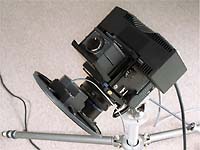 |
This not only rendered the filters susceptible to damage, fingerprints and dust but also allowed the image to be affected by flare from unwanted light. |
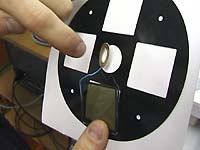 |
So Sinar designed a special camera body, the Sinarcam, to interface with their existing modular view camera system and provide high-quality behind-the-lens filters, and a new shutter. |
|
|
The internal filters, made of glass, were hidden inside the camera body away from dust and extraneous light. |
Sinar also introduced Sinaron 'digital' lenses, a series specially selected to match the pixel size and resolution of the CCD. A sophisticated 'compendium' bellows lenshood (matte box) was designed, to prevent all but the actual light which forms the image reaching the lens. Few photographers realise just how much image quality, contrast and colour saturation are reduced -- and flares increased -- by non-existent or poorly designed lenshoods.
The Sinarcam body will take special Sinaron Digital lenses, Nikon, Leica-R, Olympus, Hasselblad, Mamiya 645 or Sinaron large-format lenses in focussing mounts. The 24 x 36mm chip in the Leaf Volare back can therefore be used with 35mm camera lenses, which match the format of the sensor and give the same lens angles as when used on 35mm SLRs.
A new Sinarcam starts life as a
block of Aluminium Alloy. The block is machined in a
computer-controlled milling machine. This reduces the two halves of
Sinarcam to thin -- but solid -- parts. After machining, all the parts
are carefully checked for accuracy. Finally, the two halves fit
snugly together.
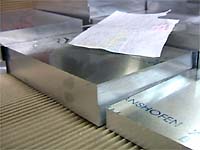
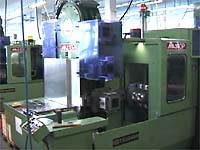
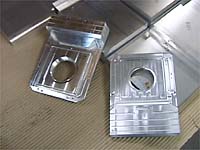
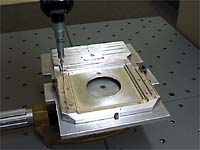
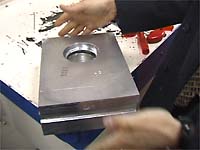
DIGITAL BACK -- THE SINARBACK
With Sinar's unique experience, it was not surprising that they decided to make their own digital camera back, the Sinarback, which was unveiled at the company's fiftieth birthday celebrations, just before Photokina 1998.
Sinarback can be attached to medium format cameras, or to the Sinarcam 2 where it marks up a 'first' in professional digital cameras: the first time that a complete digital camera system -- front and back -- has been made by one manufacturer.
Sinar use one of the new Philips 'building block' CCDs -- made by 'stitching' together multiple 12 x 12 mm 1MPixel blocks -- but not the 24 x 36mm FTF3020 used by Dicomed, Leaf, MegaVision and Phase One. Sinar's sensor is square, consisting of four 1MPixel blocks, stitched into a 24 x 24mm 2048 x 2048 pixel device which is actively cooled, to reduce noise and increase dynamic range. This square format is similar but smaller than the 30.72 x 30.72mm Loral Fairchild CCD442A used by Leaf and others.
A major advantage cited by suppliers of cameras using the 24 x 36mm chips is that a 1.5-to-1 aspect ratio image require less cropping for most picture uses. In effect, cropping any digitally captured image 'throws away' scarce and costly pixels. Cropping Sinar's 2048 x 2048 pixels images to a 1.5-to-1 format results in images only 2048 x 1536 pixels -- a lot of waste -- and final 24 bit file sizes of only 9MB. Maybe a nine (3 x 3) block CCD stitch to produce a 36 x 36mm, 3072 x 3072 pixel, CCD would be a good idea? Lenses for 35mm cameras produce a circular image a little over 50mm in diameter and should be able to cover this area. Sinar's choice may have been dictated by such factors as availability, delivery time and cost. If the CCD configuration is not an already adopted one, the cost of CCDs from Philips is higher. However, there is nothing to stop Sinar offering alternative CCDs in the future.
The Sinarback CCD has pixel-level colour filters, so it can be used for live subjects. An LCD shutter enables a 7fps monochrome/4fps colour 'live' image to be viewed on the monitor. An alternative method of shooting, for static subjects, is in four-shot mode, using two piezo drives to shift the exposed area by one pixel at a time, making up a block of four exposures. In this way, each point of the subject is analysed through each of the pixel-level colour filters, removing the need for interpolation.
Sinar also offer the option of upgrading Sinarback to a Macroscan version, which will tile up to a dozen individual images to produce an image up to 6144 x 8192 pixels -- nearly 150MB at 24 bit RGB. The Sinarback will fit all Sinar large format cameras, from the earliest Sinar Norma to the current P2. A 'Liveloupe' focusing facility allows precise control on the host computer screen at full resolution.
The camera is driven by CaptureShop software in a window divided into three sections: Capture, Process and Export. The software is designed to be intuitive and familiar to anyone who uses Adobe Photoshop. A capture rate of one shot every second is possible, using a fibre optic link between the camera back and computer. Colour calibration, producing an ICC profile, is achieved by photographing a Macbeth color chart and comparing the values obtained with reference values.
In the limited time available I was able to take only one shot -- a portrait of Carl Koch for the Seybold program. Processing was very fast and the image has superb tonality and is free of colour aliasing artifacts. There is no doubt that this is a very capable camera.
The arrival of a company with the skill and experience of Sinar in the field of digital camera design is bound to be viewed with interest -- and maybe more than a little concern -- by the other players.
The design and manufacture of Sinar's whole system is carried out in house, under their own precision control. I would like to see them diversify from view cameras, which are not so popular as they used to be, and produce a small, portable digital SLR to take the 24 x 36mm CCDs and existing Canon- and Nikon-fit lenses. That would really be something. Sinar do not do things by halves: they are perfectionists and that is reflected in the quality of their products.
|
|
|
|
|
The first (rough) machining of the assembly used to carry the two piezo drives (in the recesses at the top and right) which shift the exposed area by one pixel at a time to make up a block of four exposures. |
|
|
Electro-erosion under water, using a moving wire which is electrically charged, gives the piezo-shift unit its final precision detailing. |
|
|
The finished parts are ready for assembly. |
|
|
An Infra-Red filter covers the CCD sensor, protecting it not only from long-wavelength light but also from dust. |
|
|
The Sinarback is an aluminium casting -- |
|
|
-- to which is fitted a plate, which effectively forms a Faraday cage around the sensor, protecting it from radio frequency interference. |
|
|
Heat is shed from the sensor by active cooling through this Peltier effect radiator, fitted onto the back of the CCD. |
|
|
After assembly, the camera is checked thoroughly. |
|
|
The IR filter is cleaned to ensure that no dust remains. |
|
|
Then a test exposure is made, using a flash tube through a white diffusing screen, to check for pixel-level defects. A special toning curve makes any defects immediately apparent. |
|
|
A specially designed test chart is used to check other camera parameters. |
|
|
Power Supply Units are also assembled in the Sinar works. |
|
|
In the studio, the Sinarback is mounted on a Sinarcam 2 and a bellows matte-box added to the rail. |
|
|
Precise framing is carried out using the camera's lateral movements and the 'live' video feature, viewed on an LCD panel or computer monitor. |
|
|
Finally, toning adjustments are made on the touch-sensitive screen and the exposure is made. |
|
The images for this article were photographed in available light using a Sony DCR-TRV900 digital video camera. The still frames were captured from the DV tape using a FireWire card and PhotoDV from Digital Origin (formerly Radius Inc.) |
|
Special thanks to Carl J Koch, Marketing and joint Managing Director (who allowed me to video throughout the Sinar factory to bring you the accompanying pictures); to his father Hans-Carl Koch, Chairman and CEO; and Anselm Schwyn, PR Manager; Sinar AG. For further information about Sinar products see www.sinar.ch/edefault.htm |
|
DIGITAL PHOTOGRAPHY NOW! special interest seminar Want to know more about Sinar's digital products and philosophy? The joint Managing Director of Sinar, Carl J Koch, is one of the many manufacturers, designers and users who will share their experience with you, first-hand, at the whole-day Digital Photography Now! special interest seminar at Seybold Boston on Tuesday 2 March 1999. Also speaking is dr.ir. Albert J P Theuwissen, head of Philips Imaging Technology in Eindhoven, Netherlands. He is the designer responsible for the new CCD used in the Sinarback and other professional digital cameras which have become the catalyst for five new high-resolution professional digital camera backs. We have a page with further information about this special day and other sessions on digital photography being organized by EPIcentre's John Henshall. Did you know that, staying over Saturday night, a return trip by British Airways from London to Boston can cost as little as £230 including taxes? That's about half the cost of a day return from London to Zurich! Don't miss this rare opportunity to evaluate some of the important developments that will have a profound effect on your imaging productivity and profitability. I look forward to seeing you there. Full information on the Seybold Boston seminars and expo website. |
This is an extended version of the article which first appeared as "John Henshall's Chip Shop" in "The Photographer" magazine, March 1999.
IMPORTANT
NOTICE
This document is Copyright © 1999 John Henshall. All
rights
reserved.
This material may only be downloaded for personal
non-commercial use. Please safeguard the future of online
publishing by respecting this copyright and the rights of
all other authors of material on the Internet.
